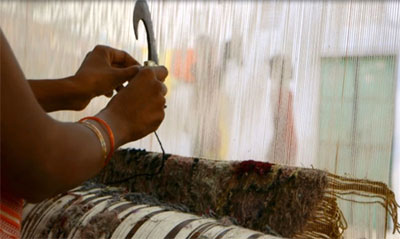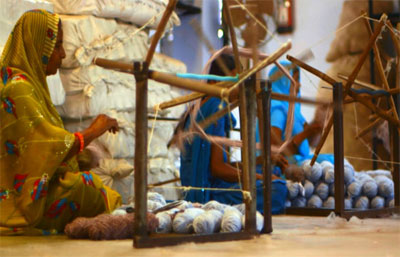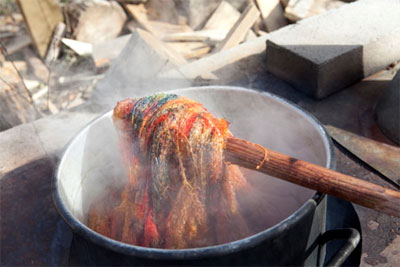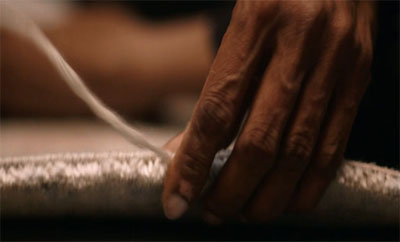Why are rugs important part of home decor?
Rugs are one of the easiest and most versatile items to decorate with in the home. Rugs brighten up a room and give warmness and calm for those who walk, sit and lie on the rugs.
If you're looking to decorate an area quickly and tastefully, or found the perfect rug and want to draw upon it as the focal point of a room, there is no disputing a room without a rug feels empty. The empty living areas and rooms beg for a rug and it almost feels wrong to do anything else to the space before we source the art for the floor.
You may have heard that carpeted houses have better indoor air quality than houses with hard floors. This is because carpet acts like a filter, pulling airborne pollutants out of the air, trapping the pollutants until they are removed with vacuum or professional carpet cleaning. So, if you've family members with asthma or allergies and you have large areas of hard floors in your home, buy a few rugs, just vacuum them regularly.
Rugs speak to you and that's the beauty of them -- they connect with different human beings for different reasons.
Diamond you can walk on
Though the key motive to buy a handmade carpet is for use, it can also be considered as a valuable investment. There's nothing lavish as the feel of silk, especially when it's on floor. Hand-made silk, wool Persian or Oriental carpets are amid the premium and most high-priced in the world.
The worth of a handmade rug is estimated by the identical factors that set the value of any work of art: genuineness, rarity, superiority & condition. They are like diamonds — the bigger they get, their prices shoot through roof! Even to untrained eyes (or toes!), these fine rugs are very different in both the way they look and feel.
All hand-knotted carpets see their value go up over a point in time.
The most expensive carpet was sold at a Sotheby's auction for a record 33.8 million dollars in 2013. It is believed to be an early 17th century Kerman carpet with a rare "vase" technique set on a red background. This record shuttered the previous sale of yet another Kerman carpet in 2010 that was sold for 9 million dollars.
Production of hand knotted rugs is forever changing.
90% of hand knotted carpets, both old and new, are being made in houses as a source of extra income. In the interior parts of India, it is the women who weave carpets which are to be sold, while their husbands take care of cattle and the farming.
The trend is changing, as the villagers are moving to the cities to search of jobs and the cities are expanding towards rural areas. Industries are erected on places where the people used to cattle farm back in time and cultivation being industrialized.
Hand knotted carpets are scarce supply and then buying a rug you can invest on is becoming much more difficult to find. Back in time our buyers did not have to make an effort to buy hundreds of hand knotted carpets at the same time. Today it is a challenge to find one single buy!
Over the past years the lack of access and introduction of machine made rugs have contributed to heavy price rises (500%) on almost all hand knotted carpets.
Within 10 years the tradition of hand knotted carpets will most likely be marginalized and in some areas die out.
Like a bottle of wine, a hand knotted carpet that is correctly maturated will certainly increase its worth making it one of the most rewarding investments one might make.
How to buy your dream rug?
The Size – It is one of the most vital points as it can make or break the design for the room. One can place Small size rugs to highlight small areas such as coffee table while large rugs work best in open areas such as a living room.
The Placement - Identify which are of the room you want to highlight. If you want the rug to bring out a particular piece of furniture, you would want to choose a subtle pattern or colour. If you want the rug to be the central point, choose a bold colour or patterns.
The Colour – For a room full of different colours, choose a neutral colour for your rug. You may also want to highlight the rug if your interiors are neutral.
Carpet material – Wool, Silk, Cotton rugs are made from natural fibers while synthetic rugs are man-made. Silk, Wool rugs are more expensive than synthetic ones.
Difference between carpet and rugs
 Rugs and carpets are synonyms in many countries. To most people carpets and rugs are the same, but this is not the case. They both serve different purposes in a home. Carpets and rugs are floor coverings that are used for style, warmth and comfort.
Rugs and carpets are synonyms in many countries. To most people carpets and rugs are the same, but this is not the case. They both serve different purposes in a home. Carpets and rugs are floor coverings that are used for style, warmth and comfort.
Carpets are wall to wall style of floor treatment and need professional help for installation or removal. After a carpet is installed, no other flooring is visible underneath the carpet. Rugs are also easier to move, clean and do not require professional help for instalment while a carpet requires constant attention, such as vacuum and requires profession cleaning in case of extensive damages. Rugs on the other hand are smaller carpets that only cover a portion or an area of the floor and not the whole thing, also earning them the name of area rugs. While carpets made to be thicker and in large quantities, they are mostly machine made and only have select designs and patterns, while rugs can also be handmade and have various designs along with depicting historical scenes. Rugs can also be hung up on a wall. Rugs are expensive compared to carpets and are more delicate in nature.
Carpets and rugs are made of similar materials such as nylon, polypropylene, wool and wool-blends, polyester and acrylic, but their designs and textures differ.
Process that creates a hand-made/hand-knotted carpet can be explained as under:
 Spinning - We receive hand spun and mill spun wool in grey form The carded wool is spun into yarn by using a charkha or a spinning wheel.
Spinning - We receive hand spun and mill spun wool in grey form The carded wool is spun into yarn by using a charkha or a spinning wheel.
Dyeing - It is our in- house dyeing infrastructure with vegetable dyeing and chrome dyeing that we colour the yarn with fast colours. These colour combinations are done by our well versed staff in our Research and Development department.
Carpet Weaving - Weaving is an art. Weavers who weave on a regular basis have a very good speed in knotting. They tend to develop this speed over a span of time. One or more weavers work on a loom depending on the size of the carpet. Each weaver makes individual knots row after row. The designs are chartered out on a graph and a map reader or another weaver instructs the graphic designs to the ones knotting the carpet. The dyed yarn is made into balls and scissors, iron rod, levers; comb beaters are used as tools.
Washing - The trimmed carpet is washed with the fresh water & chemicals. The washed carpet is dried in the sunlight up to four or five days.
Final touches - The dried carpets are given final touches byre-trimming and stretching, where ever necessary. The purpose is to bring the fabric woven in level at the surface.
Finished Rug - Finally a hand crafted is complete to give the perfect look to your living space.
History of Hand knotted Rugs
 The origin of the carpets would always continue to be masked in mystery. However, it is definitely out of the debate that woven forms of floor coverings were present during the Neolithic Age (7000 BC).
The origin of the carpets would always continue to be masked in mystery. However, it is definitely out of the debate that woven forms of floor coverings were present during the Neolithic Age (7000 BC).
The first theory says that the carpets were invented to serve the practical purpose of the rough nomadic populations. They were thickly knotted to protect the people from adverse climatic conditions. This also served the purpose of them not to give up their valuable animals for their hides. Therefore, it also fulfilled their original intention of no direct contact with the ground.
It is believed that such carpets came as rudimentary forms of floor coverings what we see today. Evolved since the early times, the previous forms of the decorated tents of the nomadic lifestyle were specimens, uniquely colour and decorated with the particular sorts of motifs and established beautification styles. In addition, they wove on the vertical loom that could be dismantled and transported easily.
Interestingly, the knotted ones were woven on the horizontal looms, which developed from its vertical cousin.
The Pazyryk Carpet was excavated from the Pazyryk Valley in the Altai Mountains, Siberia, encased and thus, preserved in ice. It dates back to 5th century B.C. It is the oldest specimen found of the ancient weavings done in the world. Such is the refined artisanship of the carpet that it definitely confirms the overview that the carpets were woven as articles to decorate the dwellings, representing them to be more inviting.
Places of Origin
 The spread of the art of the knotted carpet, over the centuries, around the globe has proved to be a interference in solving the mystery of its origin. However, many different carpet fragments have unearthed during excavations around the world. Marco Polo, the Venetian merchant and traveller, while travelling through Turkey said, "They weave the choicest and the most beautiful carpet in the world. They also weave silk fabrics of crimson and other colours, of great beauty and richness, and many other kinds of cloth." He added greatly to the fact that it all flourished in the Islamic culture that he perceived, during his world expedition.
The spread of the art of the knotted carpet, over the centuries, around the globe has proved to be a interference in solving the mystery of its origin. However, many different carpet fragments have unearthed during excavations around the world. Marco Polo, the Venetian merchant and traveller, while travelling through Turkey said, "They weave the choicest and the most beautiful carpet in the world. They also weave silk fabrics of crimson and other colours, of great beauty and richness, and many other kinds of cloth." He added greatly to the fact that it all flourished in the Islamic culture that he perceived, during his world expedition.
An antique carpet is like a "living thing"
Most of the antique forms of carpets and rugs that we see today reflect their rich weave and decorations of Persian styles. Sustaining through decades and centuries, such significant objects have lived through & are looked up with great respect and pride. Carpets woven before circa 1920 are categorized as antiques. In spite of this, there is a detailed segregation for 'antique carpets'.
Other than the year wise tagging, the traditionally woven carpets made with natural dyes or before the introduction of the synthetic dyes (occurred during 1860-1870), are fondly termed as antique carpets.
'Semi antique carpets' are those that were woven from 1860-1870 to the early 20th century. Usually, Turkish and Persian weaving has fully or partially displayed traditional decorations and motifs.
The carpets woven from 1920-1930 till today are known as 'modern carpets'. Modern carpets are normally seen inspired from the Western choices and demands. However, there was this deprivation of quality and tradition.
The above chronological classification of such 'living objects' as carpets is quite elementary. Fascinatingly, the ones that were woven before 17th century are so rare that they can only be seen in museums or large collections.